
The Echinasteridae are a family of starfish in the monotypic order Spinulosida. The family includes eight genera and about 133 species found on the seabed in various habitats around the world.

The Asterinidae are a large family of sea stars in the order Valvatida.

Astropecten is a genus of sea stars of the family Astropectinidae.

Culcita is a genus of sea stars. They are found in tropical waters. Some are kept in home aquariums.
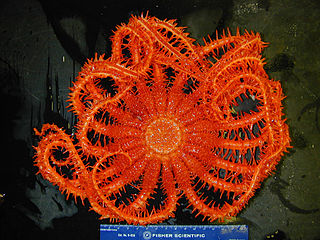
The Brisingids are deep-sea-dwelling starfish in the order Brisingida.

Psilaster andromeda is a species of starfish in the family Astropectinidae. It is native to the northeastern Atlantic Ocean where it occurs at abyssal depths.
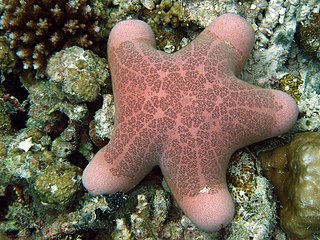
The Oreasteridae are a family of sea stars in the class Asteroidea.
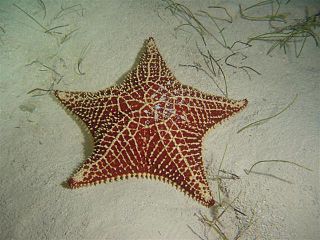
Oreaster is a genus of sea stars in the family Oreasteridae.

Pentaceraster is a genus of sea stars in the family Oreasteridae. Members of this genus are most often observed in warm coastal waters of the Pacific and Indian Oceans.

Astropecten irregularis is a sea star of the family Astropectinidae. Common names include Sand sea star.
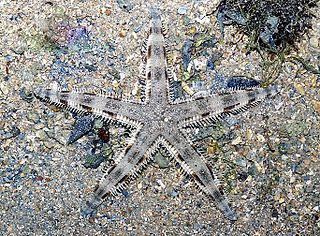
Archasteridae is a family of starfish found in shallow waters in the tropical Indo-Pacific region. The genus Astropus, previously included in this family, is now included in the genus Archaster with the single species, Astropus longipes, being accepted as Archaster lorioli Sukarno & Jangoux, 1977.

Astropecten scoparius is a sea star in the family Astropectinidae. It is found in shallow water in the East China Sea and around the coasts of Japan. It is a grey starfish and each of its five arms has a narrow pale margin. It burrows in the muddy sediments on the seabed and feeds on molluscs.
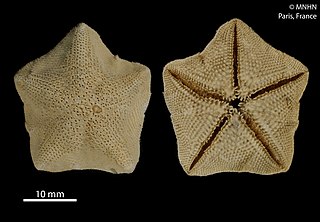
Cryptasterina pentagona is a species of starfish in the family Asterinidae. It is found in shallow waters in north eastern Australia. Its life cycle includes the release of large-yolked eggs and the development of planktonic larvae which is in contrast to the very similar Cryptasterina hystera which is viviparous. The two appear to have diverged from a common ancestral line only a few thousand years ago.
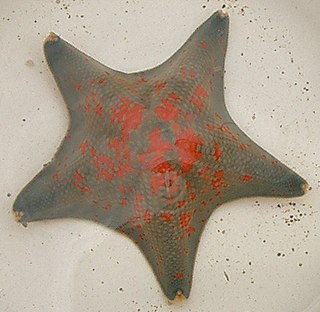
Patiria pectinifera, the blue bat star, is a species of starfish in the family Asterinidae. It is found in the northern Pacific Ocean along the coasts of Japan, China and Russia. It is used as a model organism in developmental biology.
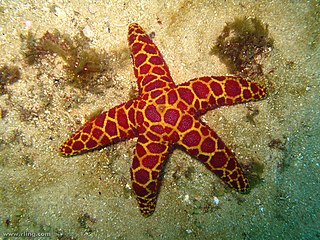
Plectaster decanus, the mosaic sea star, is a species of sea star found off the south coast of Australia. It is the only species in the genus Plectaster.

Marthasterias is a genus of starfish in the family Asteriidae. Both species in the genus are commonly known as the spiny starfish.

Pterasteridae is a family of sea stars in the order Velatida, consisting of eight genera.

Evoplosoma is a genus of deep-sea sea star in the family Goniasteridae.
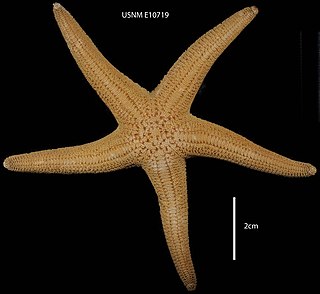
Stichaster striatus, the common light striated star, is a species of starfish in the family Stichasteridae, found in the southeastern Pacific Ocean. It was first described by the German zoologists Johannes Peter Müller and Franz Hermann Troschel in 1840.

Cryptasterina is a genus of starfish belonging to the family Asterinidae. They occur in the Indian and Western Pacific Oceans in the littoral and shallow sublittoral zone.






















